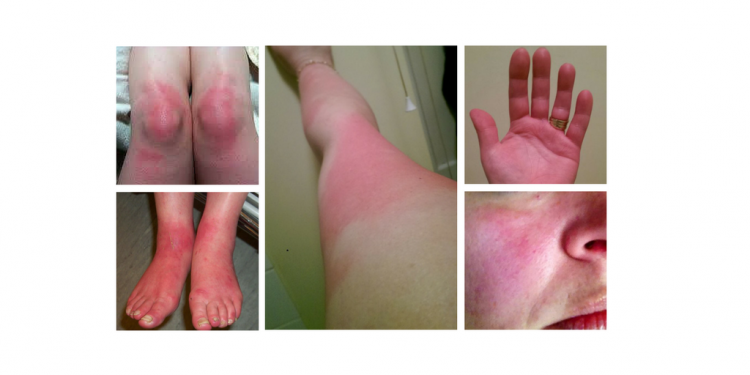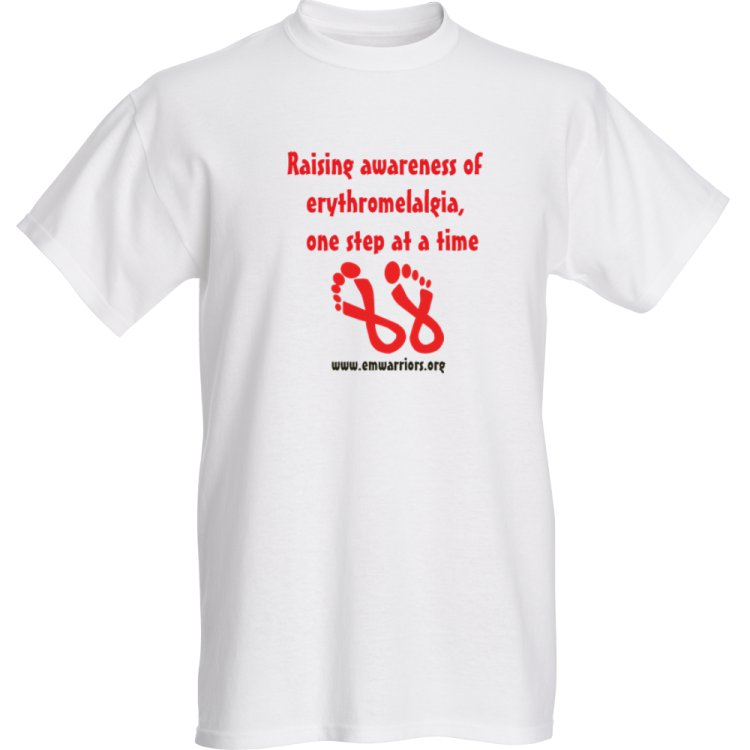My Body Felt Like It Was on Fire, but Doctors Said My Pain Was Psychosomatic
By: Mary Tomas - Erythromelalgia Warriors May 24, 2017
I advocate for erythromelalgia and volunteer with The EM Warriors.
I am a 49-year-old happily married mother of two and a doting grandmother to two wonderful little grandsons. Until the summer of 2013, life seemed pretty perfect. I had a nice home, lovely family, great friends and was about to embark on an exciting new career venture with my cousin.
I still do not understand what happened or why it happened, but almost overnight, I began to experience the most excruciating burning sensation in various parts of my body. The worst were my legs and knees, which were painfully swollen, incredibly warm to the touch and an angry red. The soles of my feet and my toes felt on fire, as if I was walking on some hot, sandy beach. An intense prickly heat traveled down my arms to my hands, which would tingle and become intermittently numb. The only way to describe this wicked pain was that it felt as if someone was branding me with a hot iron. In desperation I started to stand under a cold shower multiple times a day and use ice packs and fans to cool my burning skin. My entire body felt like it had been set on fire (literally!) and I spent most of the day lying upstairs on the bed, sobbing.
Truly, I lost count of the number of times I saw my GP and begged him for help. At first, he did not believe me. He thought my symptoms were psychosomatic and, given my age, related to the perimenopause. He even sent me to a psychiatrist to help me deal with all my supposedly “imaginary” symptoms. Over the months, my pain worsened and the burning became continuous and intolerable. Things eventually came to a head when I could no longer perform day-to-day activities like shopping and cooking for my family; even my ability to walk was affected. I was a physical and emotional wreck. I made yet another appointment to see my GP.
Because I had been met with such disbelief in the past, this time I went armed prepared with a folder full of photos that clearly showed my painful red, swollen skin. They say “seeing is believing” and this time my GP took one look at the photos and referred me to a neurologist immediately. By the time my neurology appointment arrived, however, I had spent hours searching online health sites and pretty much diagnosed myself as having a rare neurovascular condition called erythromelalgia (EM), a.k.a. “burning man syndrome.”
 Erythromelalgia flares can look and feel like second degree burns.
Erythromelalgia flares can look and feel like second degree burns. Luckily the neurologist was a kind, compassionate man who actually listened to me. He ran some nerve conduction tests and performed a skin punch biopsy, diagnosing me within two weeks with small fiber neuropathy (SFN). He had never seen or even heard of erythromelalgia, but he looked at my photos and sought advice from a colleague who informed him that around 40 percent of patients with small fiber neuropathy go onto develop a burning syndrome called erythromelalgia (EM). Following his colleague’s advice, he sent me for numerous blood tests in order to rule out other possible causes for my widespread burning (like autoimmune conditions) and I was given a Doppler ultrasound for disorders such as vasculitis and arterial disease. Eventually, in 2016, almost three years after my nightmare had begun, I was officially diagnosed as having small fiber neuropathy (SFN) and secondary EM.
Since then, I have also been diagnosed with erythrocythemia (an increase in the total cell mass of the blood). The treatment for this consists of therapeutic phlebotomies (bloodletting) every four weeks to reduce my red blood cell count and blood volume, which is bloody awful (literally!). For the small fiber neuropathy and EM, I try medication after medication on a trial-and-error basis, in the hope that one might ease my pain. I currently take gabapentin, tramadol, amitriptyline and use a numbing lidocaine cream. Do they help? No, not really, but I am luckier than some. I have a proactive and compassionate neurologist who tries his best and has even given me a NHS prescription for a novel compound cream containing midodrine. The midodrine compound cream – developed in 2016 by the Mayo Clinic in USA – is the only medication specifically for erythromelalgia.
It is hard to believe that in the space of a few years I have gone from being a healthy, outgoing, fun-loving person to an exhausted introvert! I can no longer be a part-time caregiver for my husband who has multiple myeloma or work, homeschool my youngest son or play with my darling grandsons. Currently, the burning is so severe it keeps me awake all night and heavy medication fogs my mind all day. I used to be really well groomed and proud of my appearance but now I feel too ill and too exhausted to care. Besides, due to hypersensitivity, I cannot tolerate clothes touching my skin or even wear shoes; the slightest pressure on my skin triggers the most vicious flaring. Just when I thought things couldn’t get worse, I have started to have facial flare-ups and hair loss too. To be honest, I feel like the person I used to be has died and I absolutely hate the person I am becoming.
I think my best advice to anyone worried they might have erythromelalgia is to take plenty of photos. As EM is an invisible illness, those who have it tend to look normal in between flares and, as such, are usually met with disbelief – even from experienced medical personnel. Another thing I learned was how to trigger a flare in front of the doctor. Just put an affected hand or foot under warm water and watch everyone’s jaws drop in amazement.
To those who have been diagnosed with EM, I found that getting to know my personal triggers and being proactive with cooling really helped. For example, I stay away from heat, pressure and spicy food and I never sit outside in the shade to watch my grandsons play in the garden without an ice pack and a hand-held fan.

Mary is helping to sell awareness T-shirts to help raise money for research into erythromelalgia.
During my internet searches, I stumbled across an incredible organization that truly empowered me and helped me become my own advocate. The EM Warriors not only educated me about erythromelalgia, small fiber neuropathy and myeloproliferative conditions, but they advised me how best to manage my flares and sent me tons of information on medications that I could share with doctors. Despite being diagnosed with secondary EM, I was also frightened I could have the genetic form of EM (primary inherited or familial) and pass mutations in the SCN9A gene onto my children and grandchildren. EM Warriors helped me with this too. I could not believe it when they organized free genetic testing after the UK’s National Health Service refused to cover the cost.
The EM Warriors are outstanding individuals who genuinely care, so much so that they inspired me to want to give back, so I started volunteering with them. It feels good being part of something so incredibly special – helping others the way I was helped!
Who are The EM Warriors?

The EM Warriors: Erythromelalgia Patient Support and Information Network are a self-funding charitable association dedicated to EM-powering, educating and encouraging all those living with or affected by erythromelalgia and its comorbidities.
Do you or a loved one think you may have erythromelalgia? Would you like more information about the syndrome or do you have any EM-related support needs? Visit the EM Warriors website or email their support team.
Please consider donating to help us sponsor independent research into erythromelalgia.
https://themighty.com/2017/05/erythromelalgia-small-fiber-neuropathy-journey-to-diagnosis/

No comments:
Post a Comment
All comments welcome but advertising your own service or product will unfortunately result in your comment not being published.